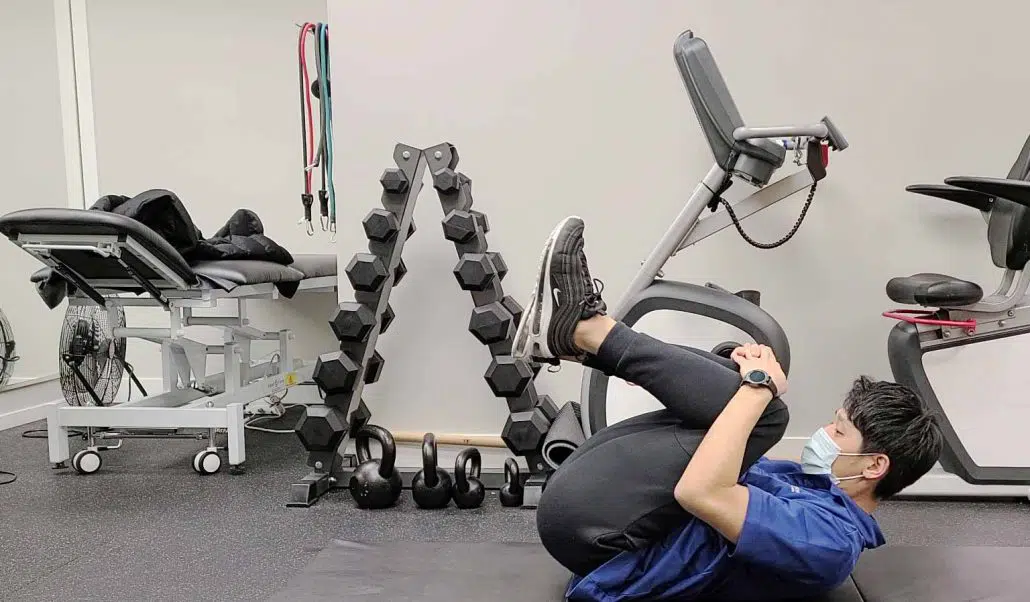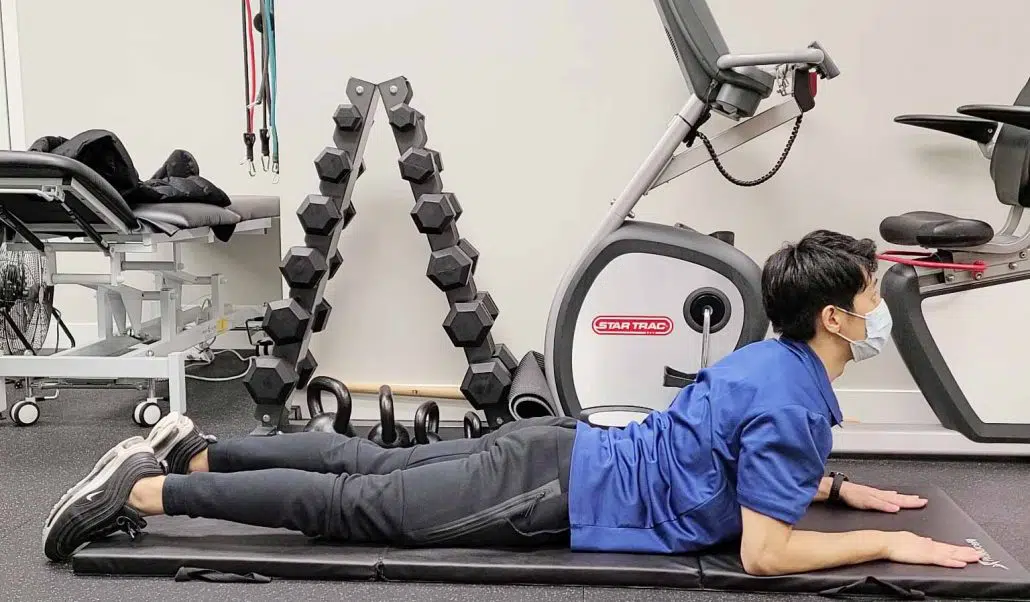Just like having a cervical disc herniation, a lumbar disc herniation is also painful. And you might be searching for ways on how to get away from this pain. It’s great to know that there are gentle exercises or stretches that can help in relieving the pain of the lumbar disc herniation. It is also ideal for strengthening and improving the flexibility of the spine and back.
What is Lumbar Disc Herniation?

The lower section of the body carries the maximum weight of the body. From L1 to L5, vertebrae are separated by shock absorbers called cushiony disks to avoid the rubbing of the bones. The annulus is the tough disc wall.
When a gel-like structure bursts out of the disc that is caused by the tear in the annulus, it causes pain in spinal nerves that is called Lumbar disc herniation. The pressure that the herniated disc feels causes the pain, inflammation, and swelling leading to the restricted movement.
The Causes of Lumbar Disc Herniation
There can be many reasons for lumbar disc herniation. Some of the most common reasons for lumbar disc herniation are;
- Aging – As you become older, the bones and discs become less flexible and can get any disease and ruptures even with minor strain or twist. It is called disk degeneration.
- Lifting heavy objects – When you lift those objects that are out of your capacity and you back can’t bear its load, and then you suffer from a herniated disc due to twisting and turning.
- Smoking – Smoking makes the blood flow limited to the lumbar area. It makes the discs less pliable which leads to the herniation.
What are the Symptoms of Lumbar Disc Herniation?
The symptoms of lumbar disc herniation vary from the amount of gel-like structure ruptured and the way this is touching the nerve roots. The most common symptoms of this are;
- Continuous back pain. Sudden movement through coughing, sneezing, or standing can make it worse that can be unbearable.
- Contraction of the back muscles
- Saddle pain
- Sciatica – pain that starts near the back or buttock and travels down the leg to the calf or into the foot
- Weakness
- Numbness or tingling in the leg or foot
- Changes in bladder or bowel function
- Restricted trunk flexion
- Numbness in the affected area
- Decreased reflexes at the knee or ankle
What are the complications?
Lumbar disc herniation is very dangerous that it can cause permanent weakness or paralysis. Sometimes, it can press the whole spine nerve system that can lead to these dangerous situations. One should seek for the treatment if;
- Symptoms worsen – The type of pain that can cause restricted movement of the body or may hamper the daily life activities.
- Bladder or bowel dysfunction – Difficulty in urinating.
- Saddle anesthesia – It is the kind of symptom that can cause a spinal block. It can manifest anesthesia to the lower part of the body i.e. legs and thighs.
Why exercises are best to cure lumbar disc herniation?
Up to 80% of the individuals face the lumbar disc herniation problem that can cause pain in the different areas of the back. It can be treated medically but also there are nonsurgical treatments i.e.
- Exercises
- Self-Care
- Medication
- Steroid Injections
- Physical Therapy
The most important and effective are exercises that a person can do at home to get rid of this pain and get back to normal life. Gentle exercises play a great role in improving and strengthening the flexibility of the spine. It reduces pressure on the spinal area. The best gentle activities are yoga, cycling, walking, and swimming.
All the exercises should be performed in a slow and controlled manner. If pain starts then one should stop performing it and should consult the doctor.
5 Ideal Exercises for Lumbar Disc Herniation
1. Back Flexion Stretch

An exercise that will stretch the back muscles as well as the spine muscles. Before performing it, ask the doctor for the proper positions. To perform it, the steps are;
- Lie on the back.
- Then, it’s time to hold both of your knees toward your chest.
- Also, move your head forward until you feel relaxed on stretching across your mid and low back.
- Repeat it several times.
2. Knee to chest stretch


This exercise must be gentler because it covers up the knee to chest muscles that have to undergo the stretching process.
- Lie on your back while having your knees bent
- Keep both heels in contact with the floor.
- Then, try placing both hands behind one knee and pull it toward your chest.
- Follow the same step on the different knee and repeat it multiple times.
3. Piriformis muscle stretch

This exercise is performed by making the buttocks the main stretch point at deep.
- Start by lying on your back with your bent knees.
- Then, keep both of your heels keeping contact on the floor.
- Have your one leg cross on the other while resting your ankle on the bent knee
- Then, you will gently be pulling your crossed knee towards your chest until there will be a stretch on your buttock.
- Repeat on the other side.
4. Spinal decompression

As we know that most spine problems are due to poor posture and continuous sitting in one posture. So, some neutral position can help to get out of this hard situation.
- Stand up with a good posture.
- Use a bar or any door top.
- Hang for 30 seconds and perform this under 3 sets.
- Release slowly.
- If you feel pain, then stop.
5. Half cobra pose

This stretch exercise allows for improved healing. It works by pushing the disc material back towards the desired position.
- Lay down on the ground.
- Keep your hips in contact with the floor.
- Prop up yourself while keeping the same posture.
- Slowly move down after 15 to 30 seconds.
- 10 repetitions are best.
Prevention:
The following are the preventions that can keep you safe from lumbar disc herniation;
- Exercise – Exercise supports the spine system and helps it to work efficiently with more functionality. In short, exercise improves and increases the functionality of the body.
- Maintain good posture – Straight and aligned back can avoid this disease. Maintaining good posture especially when sitting for a long time reduces pressure on the spine.
- Maintain a healthy weight – Already spine has the whole body’s pressure, especially the lumbar area. When the weight will increase, it is obvious that the pressure on the spine will increase. So, maintaining a healthy weight reduces the chances of disc herniation.
- Quit smoking (if any) – Smoking leads to many diseases and decreases the proper blood flow to the spine area. It is better to quit smoking to avoid disc herniation problems.
Need Help with Your Lumbar Disc Herniation?
At Evergreen Rehab and Wellness, we have healthcare professionals that can help you with your herniated disc. We have licensed chiropractors, physiotherapists, acupuncturist, and registered massage therapists that can help you with your condition. You may book online for our services. Let’s help you get away from pain.
Evergreen is Everywhere for Everyone – Let’s Help You Achieve Your Health and Wellness Goals
At Evergreen Rehab & Wellness – Coquitlam, we have registered Kinesiologists to guide your with your personal training.
We don’t only have Kinesiologists in Coquitlam, we also have Kinesiologists in Surrey that are always ready to provide patients in these areas with custom and high-quality care.
Moreover, we also have Kinesiologists in Langley that can help you.
Sign-Up Today!
Get the daily those of health and wellness tips and the latest offers across our clinics.





